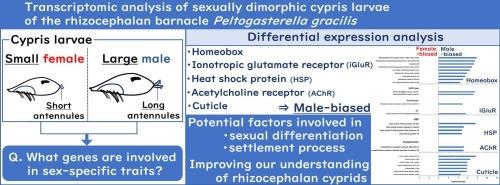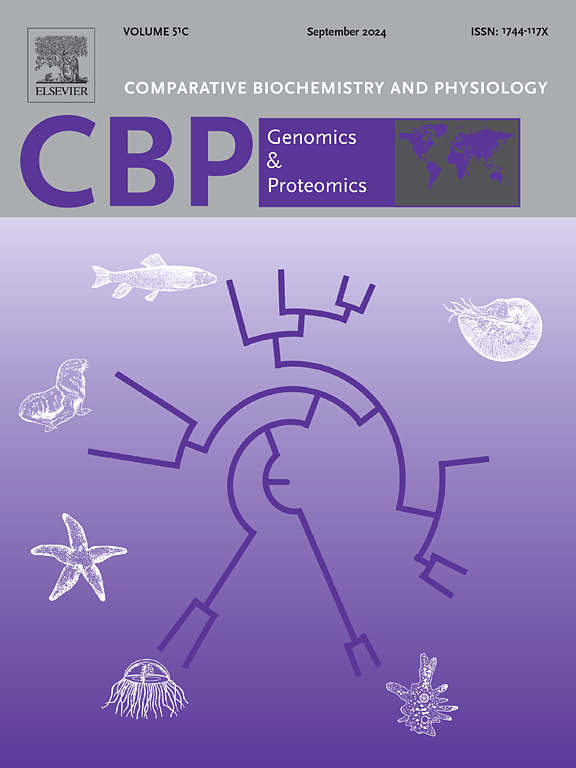根瘤藤壶 Peltogasterella gracilis 性双态胞幼体的转录组分析。
IF 2.2
2区 生物学
Q4 BIOCHEMISTRY & MOLECULAR BIOLOGY
Comparative Biochemistry and Physiology D-Genomics & Proteomics
Pub Date : 2024-10-16
DOI:10.1016/j.cbd.2024.101342
引用次数: 0
摘要
Peltogasterella gracilis(Cirripedia:Rhizocephala)是寄生于寄居蟹的甲壳类寄生虫,具有基因型性别决定作用。它的幼虫是浮游生物,雌性幼虫在寄主身上定居。随后,雌性幼虫通过在寄主体内传播一种被称为 "内体 "的根状结构来控制寄主的行为,并在寄主体外形成含有被称为 "外体 "的卵的囊。另一方面,雄性幼虫在未成熟的外胚层上定居,成为矮小的雄虫。P. gracilis 的胞幼虫在大小和形态上表现出性双态性。然而,目前还不了解幼虫阶段观察到的性双态性的分子机制。在此,我们进行了转录组分析,并比较了雌雄幼体的基因表达,以更好地了解它们的性分化和定居过程。共鉴定出 2870 个差异表达转录本,包括 456 个雌性和 2414 个雄性偏向转录本。在雄性偏向的转录本中,包括离子型谷氨酸受体、热休克蛋白、乙酰胆碱、同源染色体和角质层相关的转录本。此外,29 个基因本体术语与性别特异性相关。本研究加深了我们对根瘤藻类性别决定、性分化和定居过程的了解。本文章由计算机程序翻译,如有差异,请以英文原文为准。

Transcriptomic analysis of sexually dimorphic cypris larvae of the rhizocephalan barnacle Peltogasterella gracilis
Peltogasterella gracilis (Cirripedia: Rhizocephala), a crustacean parasite of hermit crabs, displays genotypic sex determination. Its larvae are planktonic, and female larvae settle on the host. Subsequently, the females control the host's behavior by spreading a root-like structure called “the interna” within the host's body, and form sacs containing eggs called “the externae” outside the host's body. On the other hand, male larvae settle on immature externae and become dwarf males. The cypris larvae of P. gracilis show sexual dimorphism in size and morphology. However, there is no understanding of the molecular mechanisms underlying the sexual dimorphism observed at the larval stage. Here, we conducted a transcriptome analysis and compared the expression of genes in male and female cyprids to better understand their sexual differentiation and settlement processes. A total of 2870 differentially expressed transcripts, comprising 456 female- and 2414 male-biased transcripts were identified. Among the male-biased ones, ionotropic glutamate receptor-, heat shock protein-, acetylcholine-, and homeobox-, cuticle-related transcripts were included. Additionally, 29 gene ontology terms were associated with the sex-specific traits. The present study improves our understanding of sex determination, sexual differentiation, and settlement processes of rhizocephalans.
求助全文
通过发布文献求助,成功后即可免费获取论文全文。
去求助
来源期刊
CiteScore
5.10
自引率
3.30%
发文量
69
审稿时长
33 days
期刊介绍:
Comparative Biochemistry & Physiology (CBP) publishes papers in comparative, environmental and evolutionary physiology.
Part D: Genomics and Proteomics (CBPD), focuses on “omics” approaches to physiology, including comparative and functional genomics, metagenomics, transcriptomics, proteomics, metabolomics, and lipidomics. Most studies employ “omics” and/or system biology to test specific hypotheses about molecular and biochemical mechanisms underlying physiological responses to the environment. We encourage papers that address fundamental questions in comparative physiology and biochemistry rather than studies with a focus that is purely technical, methodological or descriptive in nature.

 求助内容:
求助内容: 应助结果提醒方式:
应助结果提醒方式:


